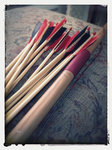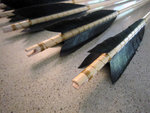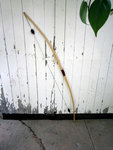 Narrowsburg
NarrowsburgLight Rain Fog/Mist, 43°
Wind: 8.1 mph
 Narrowsburg
NarrowsburgWith Mother Nature slowly wrapping the arms of autumn around our corner of the world, many shift their focus to the plethora of opportunities appearing on the menu for those who enjoy hunting. The …
Stay informed about your community and support local independent journalism.
Subscribe to The River Reporter today. click here
This item is available in full to subscribers.
Please log in to continue |



With Mother Nature slowly wrapping the arms of autumn around our corner of the world, many shift their focus to the plethora of opportunities appearing on the menu for those who enjoy hunting. The colorful pallette of leaves creates a gorgeous backdrop as hunters take to the woods, and many choose to increase their time afield by pursuing game with archery tackle.
Bowhunting seasons usually start earlier and run longer than most seasons that allow the use of firearms. Bowhunters make a conscious decision to take up stick and string, because pursuing game with a bow and arrow immediately changes the game to one of a relatively up-close and personal endeavor. While the average rifle used for deer hunting will bring down a whitetail or black bear up to hundreds of yards away, the bow and arrow limits most archery hunters to a distance of about 30 yards or less. Sure, there are some hunters who can fling an arrow consistently and accurately at longer ranges, but for the most part, archery equipment is used to take game at close range.
For those not familiar with the key points of bowhunting, there are some basic differences between hunting with a bow and arrow versus a firearm. A bullet from a firearm delivers many foot pounds of kinetic energy to the point of impact. The resulting shot and tissue damage are what cause the animal to expire. An arrow must be tipped with a razor-sharp broadhead to be passed through the vitals of the game, and blood loss is what causes death.
Mind you, that broadhead tipper arrow is extremely lethal, and videos available on the Internet will show that even the largest of bears will succumb to a well placed shot in scarcely 15 seconds. Another interesting fact is that studies have been conducted and have proven that a razor-sharp broadhead causes little pain to the game, and if by chance the shot proves non-lethal, that the animal stands an excellent chance of a clean heal and recovery.
Of course, the choices for an archery hunter are as numerous and varied as the needles on a cactus. If one were to visit a sport shop or open the catalog of one of the large stores, one would be faced with many, many choices. Among those choices are modern compound bows made and marketed by a variety of manufacturers and traditional bows such as longbows and recurve bows. And in many states, crossbows fall under the archery equipment umbrella. Longbows and recurve bows are basic, simpler in design and construction. Compound bows add wheels and cams to limbs of glass and carbon and composites to increase strength and provide the shooter some relief at full draw from the weight of the bow’s draw.
No matter the style of bow, the shooting process is similar. As it sits on the table, a bow will not fire. A shooter must draw that bow by pulling the string back and charging the limbs with energy. With an arrow knocked to the string, the shooter releases the string and the energy is transferred to the shaft, sending it down range. The draw weight of the bow, coupled with shooter size and strength, weight of the arrow and a few other components, determines how much weight the shooter must pull and hold, and subsequently how far and how fast the arrow will travel.
The gamut of gear runs about as far across the budget spectrum as one might expect. One need not bankroll the family fortune to get into bowhunting, with used gear available in sport shops and online, and many bowhunters change out gear routinely as new models catch their eye.
As a child I shot longbow and recurve bows. They were fiberglass and meant for target shooting only. However, they inspired a desire in me I might not otherwise have known that I had. I bought a compound bow early on and have been through too many to count at this point. Like many others in the hunting world, I became good with that bow, at decent ranges, and have now decided it is the pursuit, the hunt, rather than the kill I desire. As such I find myself taking up a recurve bow these days. It is a simple bow with a string, no wheels no cables, no sights to help me out. This is an up-close-and-personal experience that rings in the essence of the hunt.
My sentiment is shared by plenty of other bowhunters and bowyers, including Joseph Frye of Bold Archery Designs in Jeffersonville, NY.
“I actually started making bows when I was a little kid,” said Frye. “I was raised in the south without a lot of money. We lived on the edge of the swamp, so there was lots of material to make bows and arrows with. I didn’t have anybody to teach me how to do it. The bows I made were nothing to win prizes with, but they were plenty good enough to take small game and fish.”
For many that is how it starts; a simple interest in wanting to hunt, and the ability to fashion or use a bow and arrow to do so. It then grows from there, with some, like Frye, choosing to develop and hone those skills at making his own bows and arrows to the point of becoming a self-taught bow maker, or bowyer.
“I actually got away from it for a while, and it took joining the Society for Creative Anachronisms (SCA) to reawaken that skill, and I just started re-teaching myself. I would just make bows and then give them away when I was tired of them.” Frye credits his partner Annette, whom he met through the SCA, for helping him turn his hobby into a business. “She helped me to realize that the craft I knew was one that people appreciated and that they would be willing to purchase the bows and leather work that I made.”
Frye says he finds that a lot of folks are getting away from the non-tradition of using modern bows and the skills associated with hunting. He is not saying anything to take away from hunting with modern gear, but just noticing a wave of hunters looking to appreciate the hunt.
“I love it,” Frye says, “I just love shooting a traditional bow. It touches something primal in each one of us when we shoot a traditional bow and I am trying to get others to feel the same sensation.”
In addition to making traditional bows, Frye crafts traditional arrows as well. “I collect feathers and cut them and use them to fletch the arrows and I knap broadheads out of glass for the arrows I make as well,” Frye said. “It’s not always easy to find the right wood for making a bow or arrows, but with practice selecting the wood to use is a skill that can be learned.”
Frye, like others, loves to see the tradition of hunting and using less-than-modern equipment perpetuated. “Putting a bow in the hand of a child awakens their mind and opens their imagination. They suddenly want to be outdoors instead of sitting in front of the television or playing computer games. If we as adults showed children that we are willing to work a little harder, maybe our young kids will actually work a little harder too.”
Comments
No comments on this item Please log in to comment by clicking here